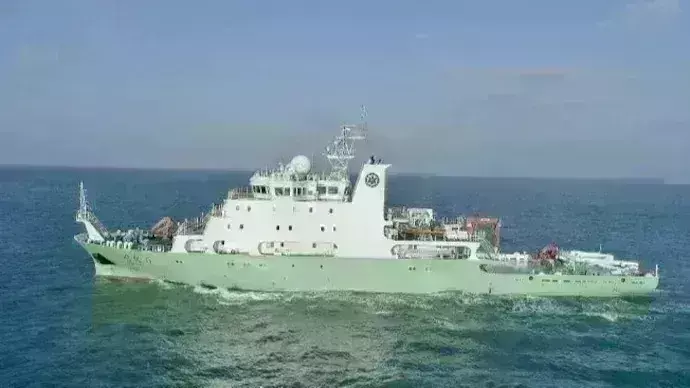India-Lanka Detente Over Sino-Lanka Relations?
Sri Lanka is likely to accept China’s developmental aid

Given India’s strategic interest in having a foothold in Sri Lanka and Sri Lanka’s wish to exercise its rights as a sovereign nation, the two countries have been having a serious problem managing bilateral relations.
This became a markedly prickly issue after China started making determined efforts to get a strategic foothold in Sri Lanka from 2013 onwards.
However, after many hiccups and controversies, Sri Lanka and India now appear to have come to an informal understanding. Sri Lanka will be free to engage China on the economic and development planes so long as it takes into account India’s defence interests.
Elements of this doctrine are in the India-Sri Lanka Accord of 1987, though it was stated in general terms, not alluding to China or any other country.
The Indian version of the Monroe Doctrine was reflected in the way the visit of the controversial Chinese research vessel Shi Yan 6 was treated and how it was resolved finally.
In April, when the visit of Shi Yan 6 was mooted, India objected to its docking in a Sri Lankan port for doing ocean-bed research in Sri Lankan waters. India felt that the vessel would collect strategic data to the detriment of India’s defence interests.
But Sri Lanka argued that the vessel, belonging to the South China Sea Institute of Oceanology (SCSIO), would be doing only legitimate oceanographic studies and that too in collaboration with Sri Lanka institutions such as the National Aquatic Resources Research and Development Agency (NARA) and the Oceanography Department of Ruhuna University.
Sri Lanka also let it be known that it would be iniquitous to ban a Chinese vessel while allowing vessels from other countries to dock at its portsSince India did not accept Sri Lanka’s argument and the Americans had also expressed concern, the arrival of Shi Yan 6 was delayed by months.
Sri Lanka said that it would formulate a Standard Operating Procedure (SOP) or a set of conditions that would apply to vessels of all nations wanting to dock in Sri Lankan ports or operate in Sri Lankan waters. As for Shi Yan 6 it was readying to come to Sri Lanka either at the end of October or in November.
But in the third week of October, Sri Lankan President Ranil Wickremesinghe visited Beijing to attend the 10th. Belt and Road Forum and meet Chinese President Xi Jinping and Vice Premier Ding Xuexiang.
The Joint Statement issued at the end of the visit said that Sri Lanka was committing itself to the Belt and Road Initiative (BRI) and that the two countries would execute a large number of development projects.
This would have been disappointing to India as only days earlier, Indian Foreign Minister S. Jaishankar had warned Indian Ocean Rim countries against accepting Chinese projects on the grounds that they were opaque and could lead to a debt trap.
It was expected that the Joint Statement would have something to say on the Sino-Lanka strategic relationship generally, and on the visit of Shi Yan 6 in particular. But intriguingly it was silent on both.
It now appears that China and Sri Lanka had quietly agreed that the ship would dock in Sri Lanka but under certain agreed conditions taking into account Indian and US concerns.
As reported by the Sunday Morning newspaper, a team of Sri Lanka Navy (SLN) officers, likely from the Navy Hydrographic Service, will be on-board the Shi Yan 6 during the stipulated two-day survey from October 30 to 31.
The vessel would dock only at Colombo, do research only off the Western coast and that in collaboration with NARA and Ruhuna University on October 30 and 31.
It will not, as previously stipulated, do any research off the Eastern Coast in the Bay of Bengal. That is because India considers the Trincomalee port and its environs on the Sri Lankan East coast an area of strategic interest to it. India also sees the Bay of Bengal as an Indian lake.
Though there is no explicit statement from the Indian side that the present arrangement is acceptable to it, it is apparent that India has accepted implicitly even if reluctantly. The reality is that a sovereign country can be forced to fall in line only up to a point.
By the same token, India has had to accept Sri Lanka’s joining China’s flagship project, the Belt and Road Initiative (BRI). In Beijing, Wickremesinghe committed Sri Lanka to the BRI in writing. He also signed up for a variety of economic development projects including some in the Tamil-speaking Northern Province in which India has had a strategic interest for decades.
Likewise, the Sri Lankan Fisheries Minister Douglas Devananda entered into a LKR. 1500 million deal with China. Out of the LKR. 1500 China pledged LKR. 500 million will be for the construction of houses for fishermen and another LKR 500 million for the provision of fishing gear. The remaining LKR 500 million is meant for providing dry rations to indigent fisher families.
North Sri Lankan fishermen have been in dire straits for decades because their fish are poached with impunity by trawlers from Tamil Nadu and were crying for assistance.
Earlier, India had opposed and successfully thwarted, on security grounds, a Chinese project to generate wind power on three islands in North Sri Lanka that are located a short distance away from the Indian coast.
Local newspapers have been quoting Chinese officials saying that China can bid for any project in Sri Lanka, including North Sri Lanka. It is expected that the Chinese will do so if only to make a point. But it appears that Sri Lanka will go by the merits of any case and will take care not to insensitively harm India’s legitimate defence interests.
Cover Photograph: Shi Yan, the controversial Chinese research vessel.



